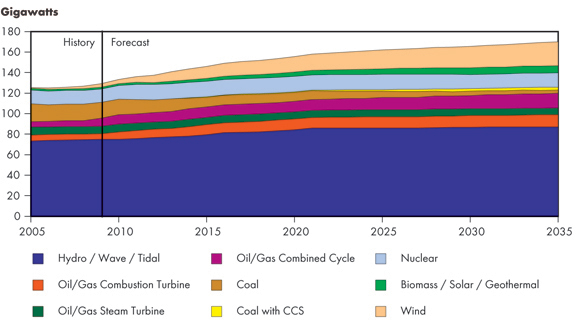ARCHIVED - Fact Sheet - Canada's Energy Future: Energy Supply and Demand Projections to 2035 - Electricity Outlook Highlights
This page has been archived on the Web
Information identified as archived is provided for reference, research or recordkeeping purposes. It is not subject to the Government of Canada Web Standards and has not been altered or updated since it was archived. Please contact us to request a format other than those available.
Fact Sheet - Canada's Energy Future: Energy Supply and Demand Projections to 2035 - Electricity Outlook Highlights
Canada's Energy Future: Energy Supply and Demand Projections to 2035 provides a "most likely" Reference Case and four sensitivity cases (based on high and low prices, and fast and slow economic growth) to 2035. The highlights below are based on the Reference Case. For detailed information, please see page 41 of the report.
Electricity supply increases to record levels as new generating capacity is built to meet steadily increasing demand.
Electricity Generating Capacity, Reference Case

- The electricity supply mix varies significantly among the provinces and territories. The electricity supply projections are driven by the demand projections, as well as provincial and utility electricity system plans.
- Total generation capacity is projected to increase by 27 per cent over the projection period, with natural gas-fired and renewable-based capacity showing the largest increases.
- Total installed capacity is projected to increase from 133 GW in 2010 to 170 GW in 2035. The capacity increases occur in all provinces and territories, with most increases in the larger electricity markets of Quebec, Ontario, British Columbia and Alberta.
- A number of federal and provincial policies and regulations result in a cleaner electricity supply mix in Canada. The addition of more renewable-based capacity, such as wind, hydro and biomass, as well as the application of carbon capture and storage (CCS) technology, reduce the emissions intensity of the electricity sector.
- Hydroelectricity remains a dominant source of Canadian electricity supply over the projection period. As a result of projected hydro-based capacity expansion, annual hydroelectricity production increases from 346 TW.h in 2010 to 430 TW.h in 2035. The share of wind-based generation triples from less than two per cent of total generation currently to six per cent in 2035. Biomass, solar and geothermal in total account for nearly four per cent of total capacity by 2035.
- Canadian electricity generation increased at an average annual rate of 1.0 per cent over the projection period, with faster growth in the 2010 to 2020 timeframe.
- In the Reference Case, net electricity available for export has the potential to increase significantly.
Electricity projections include:
- Hydro - Hydroelectricity remains a dominant source of Canadian electricity supply over the projection period. As a result of new capacity expansion, hydro-based generation capacity increases from 75 GW in 2010 to 87 GW in 2035.
- Nuclear - As a result of higher growth in other types of generation, such as wind and gas-fired, the share of nuclear in total electricity generation declines to 12 per cent by 2035, compared to 14 per cent in 2010.
- Coal-fired - Within Canada, over 9,000 MW of coal-fired capacity will be retired over the 2010 to 2035 period, or about two-thirds of the total coal-fired capacity in 2010. Natural gas-fired - The share of gas-fired generation increases from nine per cent in 2010 to 15 per cent in 2035.
- Natural gas-fired - The share of gas-fired generation increases from nine per cent in 2010 to 15 per cent in 2035.
- Oil-fired - Oil-fired generation accounts for about one per cent of total generation and is expected to maintain a very small share over the projection period.
- Date modified:
